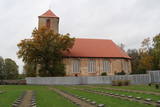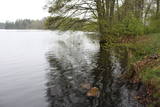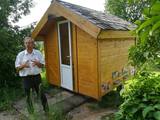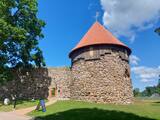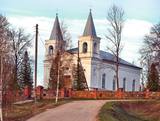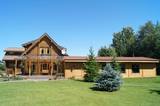| Nr | Name | Beschreibung |
|---|---|---|
|
Auf einem Friedhof neben der lutherischen Kirche von Lestene sind mehr als 900 im Zweiten Weltkrieg gefallene Krieger umbestattet worden – vorwiegend die in der Kesselschlacht von Kurland auf dem Gelände von Semgallen und Zentral-Livland Gefallenen. Zum Andenken an die Krieger ist ein von der Bildhauerin Arta Dumpe errichtetes Denkmal “Mutter-Heimat – Lettland” aufgestellt worden. Der Brüderfriedhof von Lestene ist der zweitgrößte (nach dem Rigaer Brüderfriedhof) Bestattungsplatz Lettlands der im Zweiten Weltkrieg gefallenen lettischen Krieger. Auf den Grabsteinen sind die Namen von ~ 11 000 Krieger eingraviert. |
||
|
Auf dem Bauernhof werden Ziegenmilchkäse und andere Ziegenmilchprodukte hergestellt. Hier werden Ziegen, Schafe, Kaninchen und Hausgeflügel gezüchtet. Die Produkte können Sie auf Vorbestellung kaufen, im Sommer werden auch Führungen durch den Bauernhof veranstaltet. |
||
|
It is rare type of lake in Latvia and there are only of few this type of lakes in Kurzeme region. The lake is characterized by high water limpidness (very attractive for tourists) and very rare plant species for Latvia. Nature park includes the lake, costal area and forest on the East from the lake, few smaller lakes and Sarlote Pond. There are several tourist accommodations located around the lake.
|
||
|
Südlich von der Stadt Ventspils, in der Nähe vom Küstenpark. Die Bauarbeiten der Batterie begannen im Jahr 1939. Das ungepflegte, verschmutzte und vernachlässigte Militärobjekt ist ein schroffer Gegensatz zu die gepflegte Stadt. Auch die „Gewinner” der Baumaterialien und der Metalle haben viel Mühe gegeben.... Schade, dass so ein historisches, potentielles Tourismusobjekt in solchem Zustand von den Toren der Stadt liegt.
|
||
|
Wurde für den Schutz der seltenen Pflanzenarten (auch endemische) und Biotopen an der alten Uferlinie vom Ancilus See gegründet. |
||
|
Одна из самых красивых деревянных церквей Южной Латгалии. Построенный из бревен и обшитый досками храм строился в период с 1750 по 1751 гг. Сохранился алтарь работы XVIII века (резьба по дереву, барокко) и проспект органа, а также более 30 предметов, имеющих художественную ценность. Во дворе церкви в XIX веке построена колокольня. В направлении озера Рушонс построен деревянный пасторат. |
||
|
Im historischen Eiskeller des Landguts Alatskivi werden Wein, Kräutertee, essbare Souvenirs, Gewürzessig und Konfitüren von der Ernte aus den umgebenden Wäldern und Feldern gemacht. Im gemütlichen Laden kann man Wein, Tee sowie andere örtliche essbare Souvenirs probieren und kaufen. Ist die Gruppe groß oder möchten Sie uns außerhalb der Arbeitszeiten besuchen, bitten wir Sie, Ihre Ankunft im Voraus anzumelden. |
||
|
An all-encompassing view of the urban environment next to the Daugava River valley is offered at the car park which is at the start of Augusta Street on the boundary of Krāslava. The unique wooden buildings of the area (the Kaplava Street region) can also be seen on the bridge which crosses the Daugava. Climb Karņickis Hill and hike through the park of the Plāters family of nobles. From there, you will see more local scenes.
|
||
|
"Piebalga medus" is located in Vecpiebalga region, turning off the highway Cēsis – Vecpiebalga – Madona (P30). Beekeeping, apitherapy and narration "About and around bees". Tasting and purchase of beekeeping products. A candlestick workshop is available for visitors. Especially with the fact that the apiary only with Latvian hives. |
||
|
Der Livonische Orden hat 1342 auf der größten Insel des Alūksnes-Sees – Marijas bzw. Pilssala Insel eine befestigte Burg gebaut, die mit dem Seeufer eine 120 m lange Hebebrücke aus Holz vereinigte. Die Ordensburg hatte viele Vorburgen und wurde ständig bis zum Ende des 17. Jahrhunderts modernisiert und vergrößert. Diese Burg war eine der größten Burgen im Ostteil des Gebietes, das unter der Herrschaft des Livonischen Ordens stand. Ähnliche Burgen befanden sich in Vastseliina und Isborsk. In dieser Zeit wurden um die Burg herum die Schutzwallen errichtet. Die Ordensburg bestand bis zum Großen Nordischen Krieg, als 1702 die schwedischen geschlagenen Truppen einen Zentralteil der Burg in die Luft sprengten und ergaben sich, aber die russischen Truppen vollständig vernichteten. Heutzutage zeugen von den Ereignissen der damaligen Zeit die Burgruinen auf der Seeinsel, die mit dem Seeufer – dem Zentrum von Alūksne und dem Tempelberg – zwei Holzbrücken verbinden. In einem Konzertpavillon neben der Burgruinen finden verschiedene öffentliche Veranstaltungen statt. |
||
|
Die gemütliche Gaststätte in der Innenstadt von Elva sorgt nicht nur für einen vollen Magen, sondern auch für eine freundliche Atmosphäre. In der vielfältigen Speisekarte können sogar wählerische Gäste ihre Lieblingsgerichte finden, darunter auch Veganer. Man kann Räume mieten und Essen bestellen. In der Sommersaison steht auch eine Außenterrasse zur Verfügung. |
||
|
In the southern part of Līvāni, where Zemgales Street ends at the Daugava River, there is a fairly unusual and exotic form of transportation – one of three river crossings in Latvia. Unlike the one in Līgatne, this one is operated by a motor, not the flow of the river. It involves a cable across the river, and it is based on Soviet military pontoons that were used to build pontoon bridges for tanks. The crossing point was established by its owners. |
||
|
Old Kybyn Inn in Trakai serves traditional Lithuanian food like their Karaite meat pasty – the Kybyn as well as other sorts of food. |
||
|
Sts. Simon and Judas Roman Catholic Church of Dricāni was
built in 1859 on the top of the hill. There is the wooden altar of the Holy Spirit, decorated with woodcarvings, wooden statuettes and the icon of Simon and Jude.
|
||
|
The fast-food place of a bistro type in Gulbene with a tasty lunch menu for very reasonable prices. It is also possible to try dishes typical for Gulbene district here. Working hours: Monday-Friday: 08:00 - 18:00, Saturday: 09:00 - 14:00 |
||
|
Gas mixture is the main raw material for Estonia’s energy and chemical industries, and it is extracted in our day from open quarries or underground shafts. This layer was established during the Ordovician Period between 450 and 480 million years ago, and it is made up of the remnants of plants and animals from that age. In the Kohtla-Nõmme suburb, there is a shaft which can be toured in the company of a guide who will tell you that this is the only layer of its kind in the Baltic States. He will tell you about how the gas mixture has been extracted over the course of history.
|
||
|
Das Gästehaus "Aizvēji" liegt nur 50 km von Riga und 200 m vom Sandstrand der Küste von Vidzeme entfernt, in einer ruhigen, landschaftlich gestalteten Umgebung. Ein Komplex für Feste und Erholung, Tennisplatz, Verpflegung für Veranstaltungen. Blockhaus mit zwei Bankettsälen und gemütlichen Räumen. Das Sommercafé befindet sich getrennt vom Gästehaus. |
||
|
Eine große parabolische Düne mit einer Ausstellung der Holzskulpturen unter freiem Himmel, die der litauischen Mythologie gewidmet sind. Die Skulpturen haben litauische Meister der angewandten Kunst angefertigt. |
||
|
Eins der eindrucksvollen Wasserfälle Estlands (ung. 8 m), „wiedererlebt” nach den reichlichen Niederschlägen und im Früfling bei Hochwasser. |
||
|
Die Hauptstadt Litauens. Eine der größten Altstädte Osteuropas, ist in die UNESCO Liste des Weltkulturerbes aufgenommen worden. In der Altstadt sind verschiedene architektonische Stile dargestellt: Klassizismus, Barock, Gotik, Renaissance u.a. |
||
